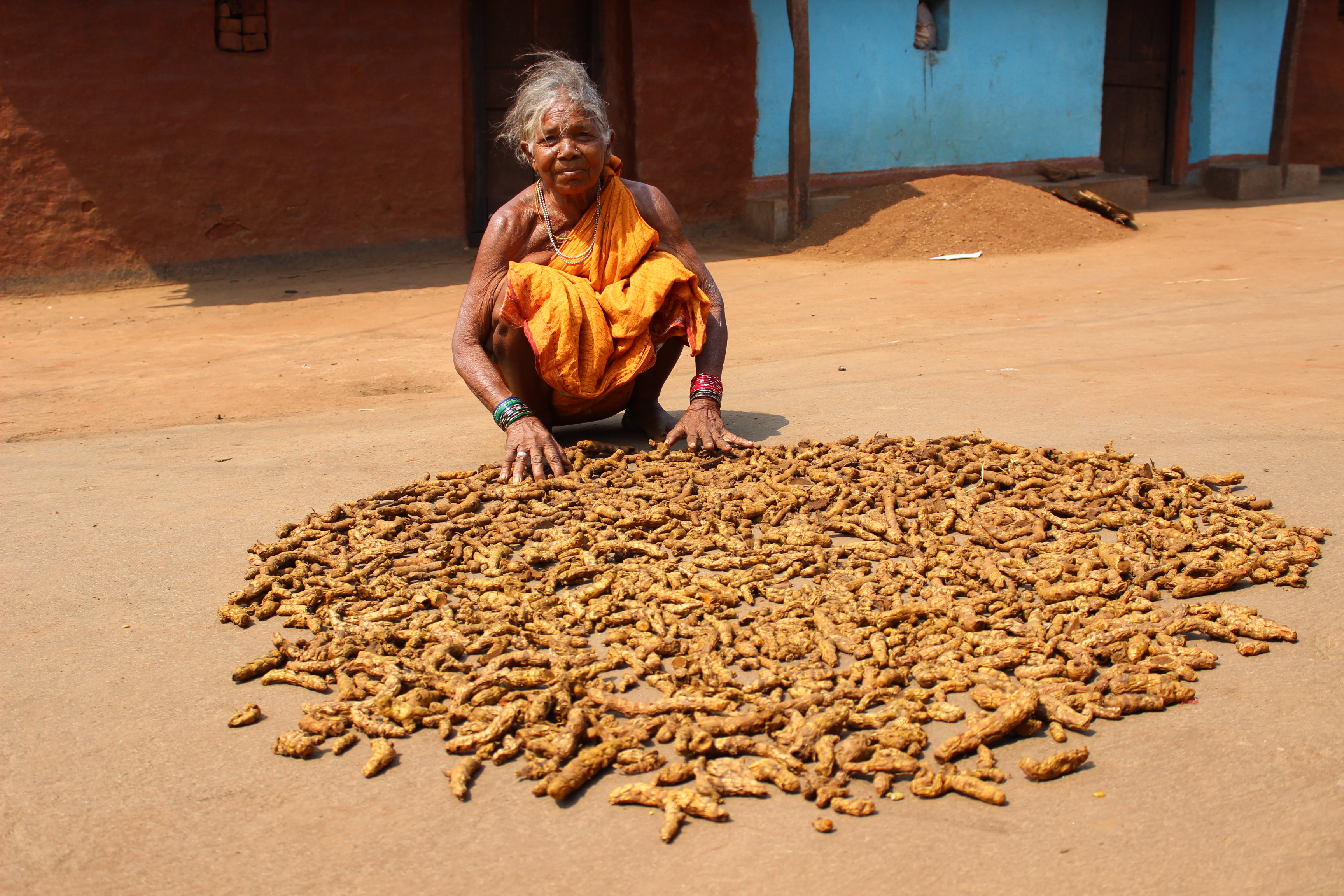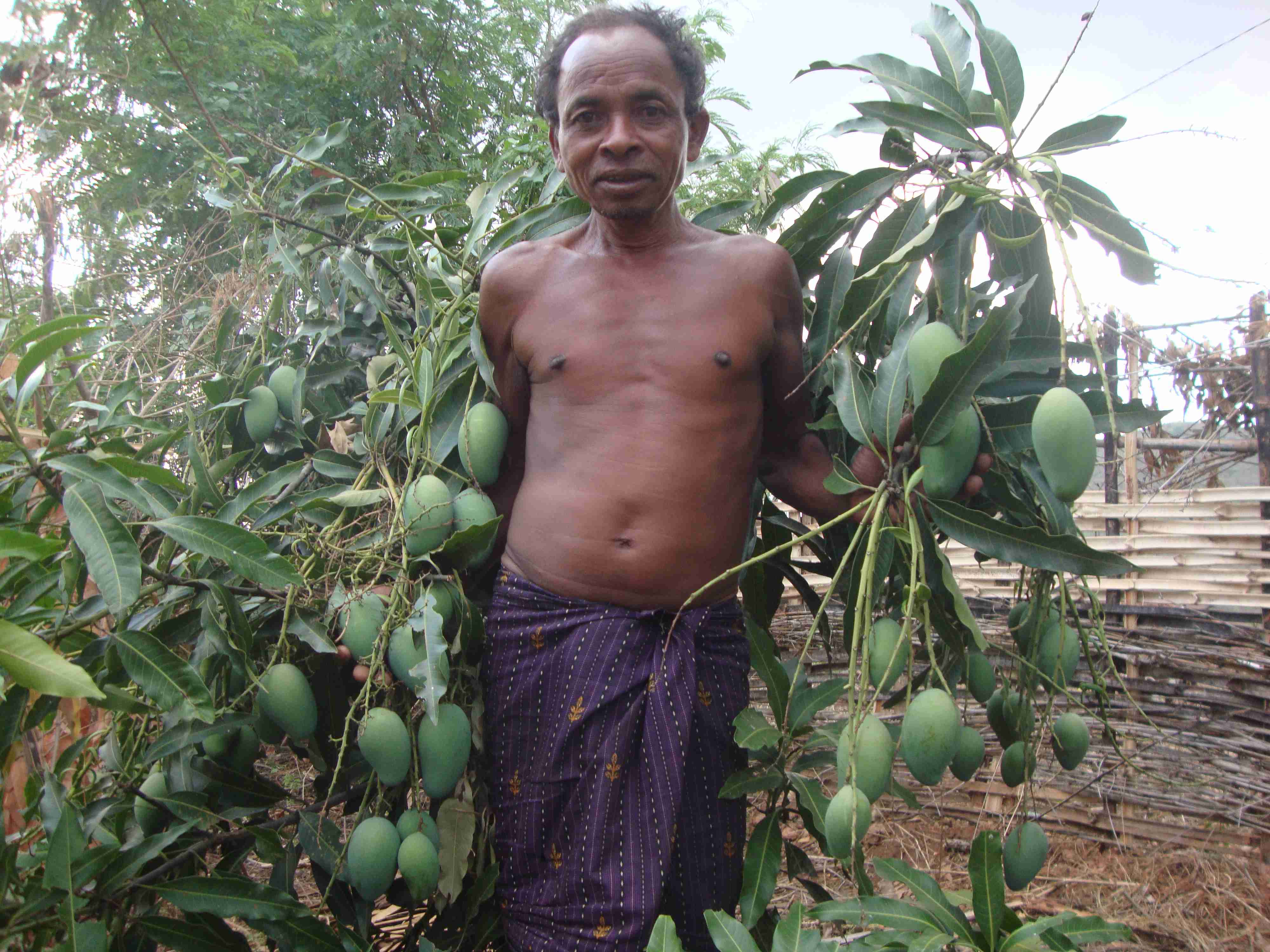Koraput district of Odisha in India is endowed with abundant natural resources and is mainly inhabited by the indigenous communities, belonging to the Paraja and Kondho tribes who primarily depend on subsistence farming. Rainfed uplands situated between hillocks and bottom-valleys, locally known as “Dangar Jami”, constitute the major portion of the arable land in the region. Millets and paddy cultivated predominantly as rainfed crops in about 90 percent of the cropped area by the farmers as direct seeded upland crops along with other food crops.
Inter-cropping and mixed-cropping of various millets, cereals, pulses, oil seeds practices by farmers helps to diversify crop cultivation and insures against crop loss due to biotic or abiotic factors. It helps to increase the cropping intensity, resulting in optimized utilization of soil, water, nutrient and sunlight and increased productivity and profit. With the introduction of hybrid seeds, chemical fertilizers and pesticides to increase the production in this region, indigenous seeds, food sources and bio-diversity are facing a severe threat to their existence while many traditional seed varieties are being lost. Hybrid varieties require substantial investments, and its yield fluctuates due to the slightest change in the climate causing economic hardships on the farmers. They also cause ecological imbalance due to high utilization of chemical inputs. Moreover, the modern hybrid seeds have failed to withstand recurrent droughts and other climatic extremities leading to increased uncertainty of food production. In this region many farmers after being tempted to buy hybrid seeds, chemical fertilizers, and pesticides, expecting a high yield have been trapped into the vortex of indebtedness to local money lenders. The requirement for long lasting solutions to these issues have required a revisit into the traditional methods for sustainable and eco-friendly practice.
To counter such negative effects of mechanization in the finance starved egions of the district, several new innovative approaches are being tried and tested to enable the farmers to gain from the technical know-how while nurturing their traditional wisdom and resources. One such promising approach is the “Wadi model” which has been successfully implemented in several States of India especially in the semi-arid and arid zone and has a high potential for replicating in other tropical and sub-tropical countries as well. The Wadi model has emerged as an integrated model of sustainable agriculture, rejuvenated the eroded and denuded landscape in particular and conserved biodiversity in general and thus seems the ideal system for implementation in the region.
Small farms combine different inputs and are much more efficient in the way they use resources. Their food production system is based on local ecology, resilient to climatic changes and nurtures bio-diversity and uses labour of both genders resulting in higher employment and ensure income security of the household.
Agragamee, a grassroot NGO actively working in this region since three decades on sustainable natural resource management started its people-centred planning for reinforcing the livelihood of the community and more importantly helped revive back many indigenous crops and techniques of farming. Since 2009, Agragamee with the support of National Bank for Agriculture and Rural Development (NABARD), India, has been implementing the “Wadi” project in 37 villages of Dasmantpur block covering 1116 tribal families. The ‘”Wadi” model consists of plantation of 50-60 orchard trees like mango, cashew and litchi on one acre land with forest species along the borders. Besides, support is also given on growing various indigenous crops and vegetables as inter-cropping and mixed-cropping to address food and nutritional security as well supplementing family income of the small farm families. The wadi plot is also provided with both live and dry fencing to protect from cattle grazing which is a persistent problem.
The farmers are provided with technical support in pit digging, graft selection, plantation, after-care activities and trained on improved agriculture and horticultural practices. Several examples of successful farmers in the region are now seeing a ray of hope for self-sufficient farming through wadi model. Take for instance Gadhav Majhi, a farmer in the Dasmantpur block who cultivates the plot along with his wife. The wadi model provides continuous and sufficient employment to a family including women, and keeps them engaged year round, without having to depend on external labor or migrating to faraway places during non-cropping seasons. Majhi first heard about the Wadi project in his village when the staff of Agragamee shared about the importance of inclusion of plantation of orchards spices along with their traditional crops in the inter-cropping and mixed-cropping systems in the medium and uplands. He shares, “Initially, we were apprehensive of survival of orchard saplings owing to prevalent rainfed conditions in the area. We were worried that the shade of the trees would adversely affect crops yield”. On the other hand, women were reluctant to adopt the Wadi model as they had been accustomed to shifting cultivation which has been in practice in the area since generations. To convince them and provide hands-on field experience, farmers were taken as a part of “exposure visit” to Gujarat State where BAIF had successfully promoted Wadis. Majhi recalls “After seeing the successful Wadi plots and interacting with the farmers in Gujarat, we were enthralled and convinced to replicate the model in our area too”.
The Wadi model had helped to reverse the ecological degradation due to shifting cultivation through promoting settled agriculture thereby improving soil condition in harmony with the nature.
Adapting the type of farming from shifting cultivation to wadi helps to not only preserve areas under native forests but also helps to regenerate forests in areas which are no more used under shifting cultivation. The predisposition of surrounding land to fire hazards resulting in loss of flora and fauna is avoided by changing from shifting cultivation to the Wadi model in this region. Soon after the development of land and fencing of the Wadi plots, farmers were provided with saplings of mango, cashew and litchi during the monsoon season to take advantage of the rainfall for initial establishment of the orchards.
The orchard trees act as wind barriers and prevent crop damage due to high winds while helping soil conservation. They also create a favorable micro-climate through continuous evapo-transpiration for better crop production. By dropping their dry leaves which act as mulch and later on get converted into humus, trees help reduce soil carbon being mineralized due to tropical temperatures and maintain organic content in the soil. Humus generated by the falling tree leaves plays a key role in improving the soil’s water holding capacity and enhances biological activity in the soils resulting in increased farm output. The water feeding roots of the trees go deep and do not compete with the surrounding crops for moisture. Farmers continue to use the prevalent form of pest control through utilization of neem based compounds like neem seed oil cake and mixtures of leaf extracts with cow dung and urine which mitigates pathogens while adding nutrition to the soil. However the villages which traditionally neglected the vegetable crop wastes have begun to recycle it by ploughing it into the soil for humus. In addition to this, now composting is adopted in villages which helps to recycle crop and vegetable waste as manure and cut cost of purchasing chemical fertilizers.
“Earlier, I used to cultivate only rice and some oilseed in the same plot. But, today, I am cultivating turmeric, grams, pulses, millets, oilseeds, tuber crops in the space between orchard trees as mixed-crop and inter-crop. Now, the yield has increases substantially and I am harvesting a range of produces round the years”, says Majhi happily. A visit to his wadi plot on the hills sides reveal the diverse crops being cultivated during different seasons through judicious use of the water available in the region (Figure 1).

Figure 1 Gadhav Majhi standing in his wadi plot inter-cropped and mixed-cropped of turmeric, vegetables, millets, oilseeds with orchard spices, In the background are the field crops interspersed with orchard crops on the bunds. Pic: Abhijit Mohanty
Ensuring food and nutritional security through promoting traditional crops and strengthening income security through cash crops
The Wadi model has helped farmers to cultivate new crops in addition to their traditional crops. For the last 3 years, Majhi has been cultivating turmeric in his Wadi and getting diverse benefits from this. Turmeric plantation as inter-crop in orchard has been found not only to assist in suppressing the population of trunk borers, termites and gummosis causing pathogens in the soil through secretions form its roots, but also provides income from the harvest of the rhizomes, nine months after planting. The mango orchards remain free from termite attack when turmeric is grown as an inter-crop. Turmeric planted as an inter-crop in fruit orchards is beneficial in organic farming systems, to control various soil-borne pests and diseases.
About mixed cropping, Majhi shares, “We cultivate upland paddy with green grams along with the orchards crops. First, we harvest paddy and after a month thereafter we harvest green gram. In this way, we harvest two different crops from same. Last year, the yields of both the crops were bumper”. It has been noticed that, mixed-cropping of legumes with cereals helps in conserving moisture, by reducing runoff, improving physical properties of soil and building-up of soil fertility owing to the nitrogen fixing ability of the legumes. Legumes like green gram/black gram being short duration crops may constitute potential crops in upland paddy under rainfed condition.
Similarly, Majhi also cultivates indigenous maize with mustard as inter-cropping. The maize-mustard system most likely originated in Africa due to the prevalent diet system where maize as a cereal was consumed in combination with the mustard greens. In the regions of Dasmantpur, farmers now consume mustard greens which help to meet their nutritional requirements providing the benefits of inclusion of a green leafy vegetable. Maize being a crop highly susceptible to water logging is well suited to the rainfed system. Each year, Majhi harvests a good yield from this pattern of cropping system. This may be attributed to the increased concentration in the nutrients in grain and stover of maize which is later ploughed back into the soil system. Secondly, due to different rooting system of maize, mustard or cereals and legumes, there is optimum utilization of moisture and nutrients from the soil. The nitrogen fixation by legume nodules and transfer to the cereal crops owing to their proper growth in the shades provided by maize canopy result in significant biomass production from maize crop. Tomatoes are also inter-cropped with maize. Prime focus has been also given to revive cultivation of various minor traditional millets as these constitute their staple food. Majhi shares, “We prepare porridge from various millets, add little maize and rice. It gives us the power and energy to work in our agricultural field”.
The Wadi model developed for semi-arid and arid tracts in the country promotes optimum utilization of locally available human and natural resources. The concepts of preventing soil and water loss with minimum utilization of mechanization and avoiding chemical for maximum sustainable productions have been equally relevant in the slopes of Dasmantpur as in Gujarat. Majhi has adopted the concepts and selected crops that fulfill the domestic and local market demands and combines high input crops with less input crops to maximize returns.
Initially, though the adaption of orchard crops was slow, these are being now integrated into the farming systems. Protecting the cultivation of traditional crops, while introducing new crops (especially orchard crops) has been the unique feature of wadi program. This has significantly addressed the food and nutritional security of farmers. The produces from orchards primarily act as cash crops ensuring a significant annual income. As seen in figure 2 both male and female members participate in pit digging for planting of orchard crops.
Farmers confined to only mono-cropping earlier had to leave their land as fallow during low rainfall years. They also faced acute food shortage during June, July, August and September when the new crop was standing in fields. During this period, the farmers, unable to get enough food, either starved or consumed non-edible stuffs like mango kernel, tamarind seeds, wild root and tubers and many other items which made them susceptible to food poisoning. But, after adopting mixed- cropping, inter cropping and growing vegetables along with orchard crops round the year, the farmers are now storing enough food stuffs as a buffer stock to meet the need of food scarcity periods. All these factors have reduced the rate of malnutrition especially amongst pregnant women and children.

Figure 2 couple collectively pit digging for orchard plantation on their wadi plot, Pic: Abhijit Mohanty
The focus has been to encourage active community participation in planning, prioritizing and executing the program which has ensured sustainability of the program. This becomes possible through local institutions building.
Agragamee firmly believes that to ensure sustainability of any development initiative, active and continuous community participation is a prerequisite. In order to ensure sustainability of the wadi projects, involvement of local communities has been emphasized. Therefore, People’s Organisations in the form of Udyan Vikash Samitis (UVSs) were formed. Generally a cluster group of 10 farmers having compact land up to minimum of 5 acres forms a UVS. The concept behind forming UVS is to assure better after-care activities and marketing. To date, total 83 UVSs have been formed, and provided capacity building and skill up-gradation training on orchard development, income generation and resource mobilisation. All the UVS were facilitated to open their respective bank accounts for smooth and transparent fund flow.
To ensure better forward and backward linkages for the farmers, a total of 15 Producers Company (PCs) were registered. Besides, 50 women’s Self -Helps Groups (SHG) consisting of 741 members were formed and many of them have been involved in successful micro-enterprise activities in several villages. This type of Community Based Organizations has collectively helped in developing saving habits, reducing dependence on moneylenders and one can experience the increased confidence amongst the women folk. They are no more confined to the four walls of their house but actively participate in the village meetings and take decisions at their end independently. Thus, they not only participate in their traditional role of post-harvest crop care and processing but have also donned new roles. In figure 3 is the picture of a wadi beneficiary drying the turmeric to reduce its moisture.
From scarcity to self-sufficiency, the farm communities regaining their self-reliance farming once again
Since the inception of the wadi, prime focus has been given on promoting organic farming practices amongst the farmers such as liquid manures, plant growth hormones and plant derived pesticides. A total of 65 Vermi-compost pits and 154 compost pits were created in all the 37 villages. The farmers have also learnt the techniques of producing and maintaining their own seed stocks of different crops. This has twin benefits for the farmers. Firstly, it reduces the cost of seed inputs and they are no more dependent on external sources. Secondly, due to the use of organic manures for the traditional seeds as compared to chemical fertilizers and insecticides for the hybrid seeds, the natural fertility of the soil has been restored leading to less reliance on chemical fertilizers.
In the instance of Sadhav Muduli, a farmer of Parajabarikanta village this has helped to avoid loans from local money lenders. He shares, “Earlier, we used to purchase seeds along with chemical insecticides, pesticides and fertilizers and paid a major part of our earning, decreasing our profit. Often we could not recover our invested amount. But now, things are changing. We have become more self-reliant and have our own seeds and know how to prepare organic pesticides and insecticides using locally available resources. We have orchard crops which provide additional income’’. Sadhav Muduli displays his harvest from orchard (Figure 4) compost pit/neem insecticide preparation in his village is shown in figure 5.
Thus, it is quite evident that tribal farmers of 37 villages in Southern Odisha, India have broken the barriers of mono-cropping by reverting back to indigenous crops based bio-diverse cropping system and including orchard species. This has significantly secured their food, nutritional and financial requirements. They now practice farming, which is more resilient to agro-climatic factors, and eco-friendly with higher outputs of diverse and nutritious food crops. The seed scarce community has moved towards seed self sufficiency and farming has transformed into a self-reliant activity. The most positive impact of all this transformation is the enthusiasm among the youths who evince a keen interest in farming, significantly reducing distress migration prevalent in this region.
Authors:
Abhijit Mohanty is a development professional based in Bhubaneswar, Odisha and holds a MBA Rural Management degree from the AMITY University, India. He mainly works on promoting climate smart agriculture amongst the indigenous communities of southern Odisha. Several of his works has been published in India Together and LEISA India.
Ranjit Sahu (Ph.D, Virginia, USA) hailing from Odisha and currently located in the United States has deep interest in nature conservation.




No Comments Yet